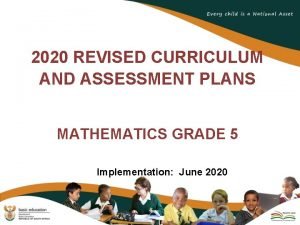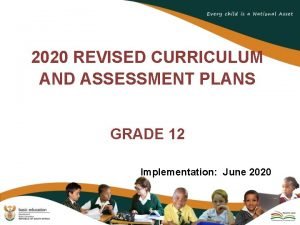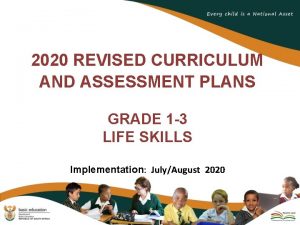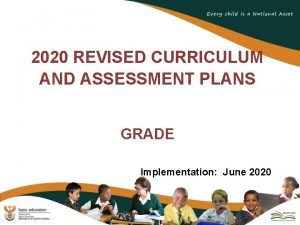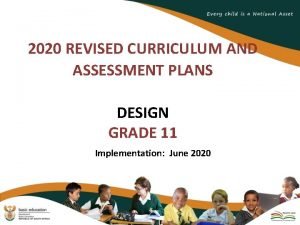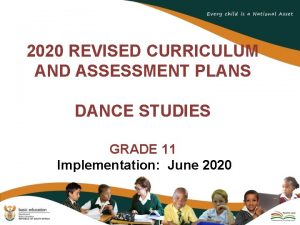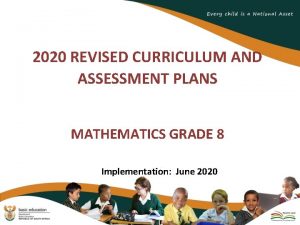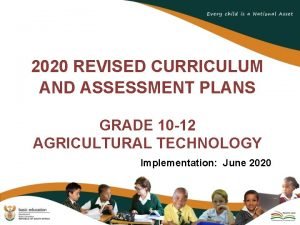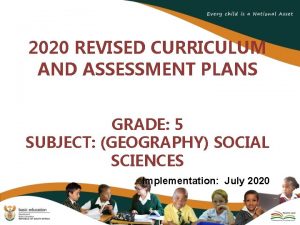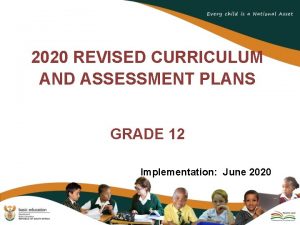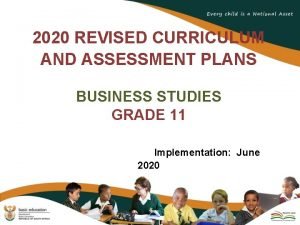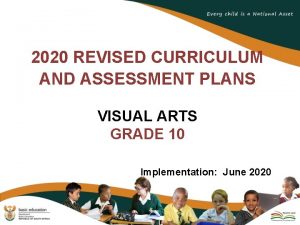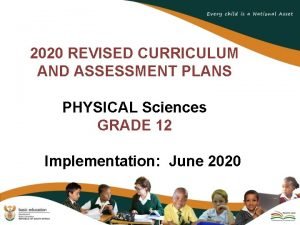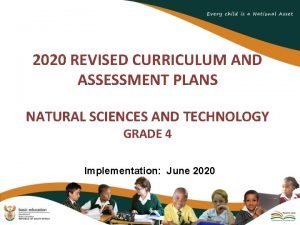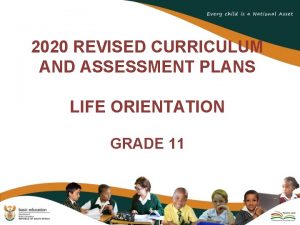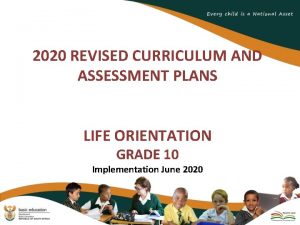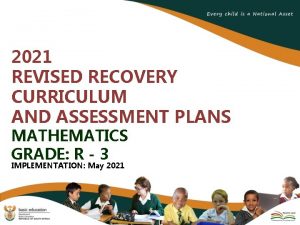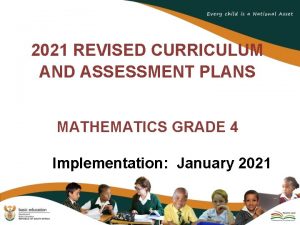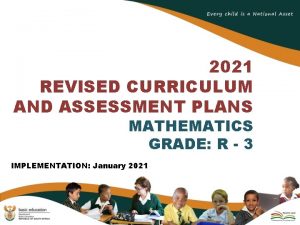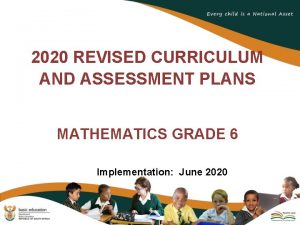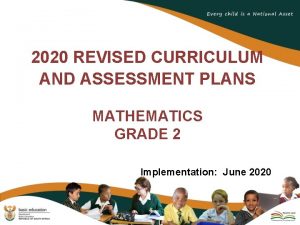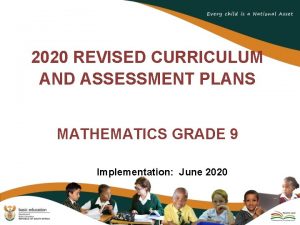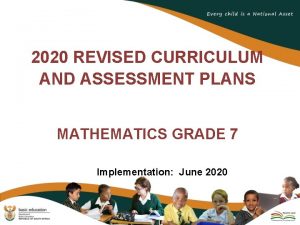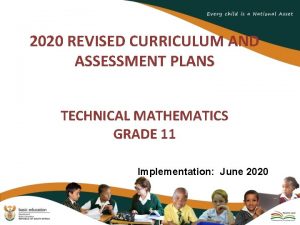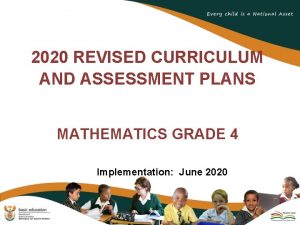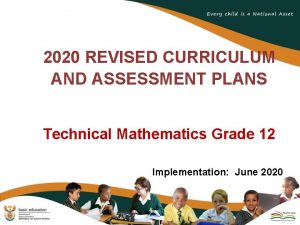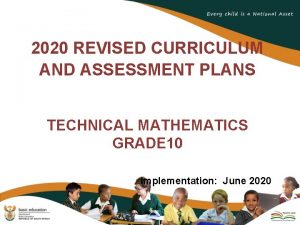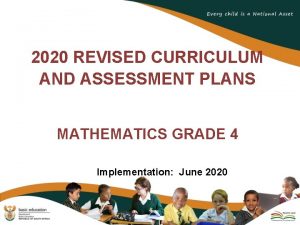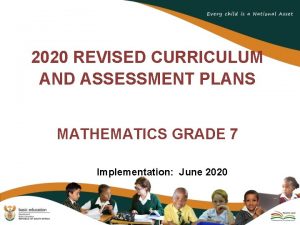2021 REVISED TRIMMED CURRICULUM AND ASSESSMENT PLANS MATHEMATICS


















- Slides: 18

2021 REVISED TRIMMED CURRICULUM AND ASSESSMENT PLANS MATHEMATICS GRADE: R - 3 IMPLEMENTATION: February 2021

PRESENTATION OUTLINE 1. Purpose 2. Curriculum • • • Principles Overview Readiness & Baseline Assessments Annual Teaching Plan 2021 Programme of Assessment (POA) 3. Conclusion

1. PURPOSE To mediate the: • Amendments of the trimmed and re-organised 2021 Annual Teaching Plan including School Based Assessment for Mathematics, Grade 1 -3 for implementation in January 2021 as stipulated in Circular S 11 of 2020 -Curriculum Recovery. • To ensure that meaningful teaching continues during the remaining teaching time as per the school calendar for TERM 1. • To assist teachers with guided pacing and sequencing of curriculum content and

1. PURPOSE… • To enable teachers to cover the core skills and knowledge in each grade within the available time. • To assist teachers with planning for the different forms of assessment. • To ensure learners are adequately prepared for the subsequent year/s in terms of skills, knowledge, attitudes and values.

CURRICULUM 2021 TERM 1

2. PRINCIPLES For the 2021 -2023 the DBE is committed to: • provide carefully planned curriculum guidelines which are CAPS compliant – and aims to ensure that all the core concepts, knowledge and skills are covered.

TEACHER AGENCY • Teachers are centre of all teaching and the work of the teachers enable learners to achieve the desired outcomes each year. • DBE plans are aimed at assisting teachers in the critical work they carry out. • Initiative that enables good teaching in less than optimal conditions is applauded and supported. • Teachers are encouraged to use their professional judgement, and available resources in order to achieve the goals set. We need a more streamlined curriculum. We need to build on the curriculum trimming TIM suggested in 2020, and reorganise the content so that deep and meaningful learning can take place. This is an iterative process and will be carried out over the next 3 years, E term by term, progressively, in order to restore the full content scope by the end of 2023. Curriculum planning will be carried out in consultation with the CONSULTATIONS whole mathematics education community to ensure that it is of the & highest possible standard and aligned with the needs of learners COLLABORATION and teachers. Deeper learning is enabled when the planned concepts are taught, the links are recognised and the practise is enabled INTEGRATION FORfor mastery. DEEP LEARNING PRINCIPL ES ASSESSMENT LINKED TO TEACHING ASSESSMENT MUST INFORM LEARNING RESOURCES CONCEPT TEACHING LINKS PRACTICE MASTERY Teachers must use their professional judgement when they plan for and do the assessments. There is no time for assessment that does not inform the way forward. Teachers should do the error analysis on the immediate recognition of the learning (written, oral, practical; formal, informal) and think about how to address these. The use of concrete apparatus are strongly advocated. Teachers must be creative and innovative. The DBE workbook is a resource given to every South African learner. Optimal use of this together with other available resources, is critical and is encouraged.

THE PHASE OVERVIEW The Content Overview shows the Grade 1 to 3 Content Areas as follows: • specification of concepts (skills and knowledge) • progression of concepts (skills and knowledge) • maps grade specific, concepts (skills and knowledge) to be acquired in Grade 1 to 3.

TERM 1 (10 WEEKS) GRADE 1 -3 CONTENT OVERVIEW FOR TERM 1 Gr 2 • Count concrete objects to 100 • Count forwards and backwards to 100 (10 s, 5 s, 2 s) • Read and write number symbols 100 • Read and write number names to 25 • Describe, compare and order numbers to 25 • Place value to 25 • Problem Solving in context to 20 (+, -) • Grouping and sharing leading to division (÷) to 20 • Money- solve problems (R, c) • Addition and subtraction context free to 20 • Number bonds to 10 • Repeated Addition leading to multiplication (×) to 20 • Mental Maths to 25, rapid recall +, - to 10. CONTENT AREA • Count concrete objects to 10 • Count forwards and backwards to 20 • Read number names and symbols 20 • Write number names and symbols to 5 • Describe, compare and order numbers to 5 • Number bonds to 5 • Problem Solving in context to 5 NUMBERS, • Addition and subtraction OPERATIONS context free to 5 AND • Grouping and sharing to 5 RELATIONSHI • Mental Maths to 5; compare PS numbers. • Geometric patterns PATTERNS, (integrated with Data handling) FUNCTIONS AND ALGEBRA • Number patterns to 20 • Geometric patterns Number patterns up to 100 (integrated into counting) • 3 -D objects (integrated with Data o Boxes, balls ( features handling) SPACE AND - size) • Boxes, balls (features- roll, slide) SHAPE • Position, orientation and views • Time MEASUREMEN • Time Gr 3 • Count concrete objects to 200 • Count forwards and backwards to 200 (10 s, 5 s, 2 s, 3 s, 4 s, 100 s) • Read and write number symbols to 500 • Read number names to 250 • Write number names to 100 • Describe, compare and order numbers to 99 • Place value to 99 • Problem Solving in context to 99 (+, -) • Repeated Addition leading to Multiplication (×) to 50 • Equal grouping and sharing to 50 • Grouping and sharing leading to division (÷) to 50 • Solve money problems (R, c) • Addition and subtraction context free to 99 • Repeated Addition leading to multiplication (×) 1 -10 by 2, 5, 3, 4 • SA money (solve money sums up to R 100 and convert Rands to cents) • Multiply 1 to 10 by 2, 5, 3, 4 • Divide numbers to 50 by 2, 5, 10 ( -, ÷, □, =) • Mental Maths – 200, rapid recall to 20. • Geometric patterns (Integrated with 3 -D objects) • Features of 2 -D Shapes • Time

ASSESSMENT: READINESS & BASELINE READINESS : GRADE 1 BASELINE: GRADE 2&3 • Readiness Assessment identifies the • Baseline Assessment helps teachers potential opportunities, challenges to understand, the learners and predicts the readiness for Grade knowledge, learning gaps and to 1. It identifies learners who may address these optimally via benefit from additional stimulation teaching, remediation or ultimately programmes and learning support developing a learning support plan. at an early stage and also informs the teachers future teaching plan to accommodate all learners. • First week of school (first 3 days) • One-on-one activity/ group activity • Written task • Requires error analysis

2021 TERM 1 RECOVERY ATPs FOUNDATION PHASE GRADE 1 GRADE 2 GRADE 3 AMENDED 2021 ATPS TERM 1

SUMMARY: AMENDMENT TO THE WEIGHTING OF CONTENT AREAS As the concepts and skills are packaged in a more integrated and unitary format: • The weighting of content areas remains unchanged. CA 2: CA 3: CA 4: CA 5: Grade CONTENT AREA (CA)1: Numbers, Operations and Relationships Patterns, Functions and Algebra Space and Shapes (Geometry) Measurement Data Handling 1 65% 10% 11% 9% 5% 2 60% 13% 12% 5% 3 58% 10% 13% 14% 5%

CLASSROOM MANAGEMENT SOME TEACHERS PREFER TO EMBRACE A GROUP teaching strategy as suggested below: • A plus, factor here is that the teacher can manage to teach the third group daily while the other groups can complete more written work independently at the tables. • 7 hours are allocated for Mathematics. Below is a suggested plan. MONDAY Group 1 and 3 TUESDAY Group 2 and 3 WEDNESDAY Group 1 and 3 THURSDAY Group 2 and 3 FRIDAY Whole class teaching consolidation of concepts taught. WEEK: 7 HOURS PER DAY 1 hr. 24 min × 5 = 7 hrs. Counting 5 min Consolidation of Concepts 10 min New Concept 20 min Group work 24 × 2 groups = 48 min

GRADE R PROGRAMME OF ASSESSMENT • In Grade R, School Based Assessment (SBA) remains 100 % continuous and ongoing. • Assessment practices in Grade R should continue to be informal and the learner should not be subjected to any ‘test’ situations. • Assessment for learning practices will continue to track Grade R learner progress for term 1. • The Grade R assessment activities should be purposely integrated across all subjects in the daily/weekly lesson plans. • The use of observations, checklists and rubrics are encouraged to record learner progress.

PROGRAMME OF ASSESSMENT • The Programme of Assessment (POA) will comprise of ONE assessment task for Mathematics per Term per Grade • The POA is informed by the REVISED SECTION 4 • An Assessment Task covers all Content Areas in Mathematics and comprises of Oral, Practical and Written activities. • Teachers teaching the same grade can team up and collaborate via respective (PLCs) groups e. g. , Whats. App, etc. and jointly develop assessment activities for this purpose. • Assessments are designed on teaching practices and where topics have not been taught, testing can still take place using the previous Grade level.

SCHOOL BASED ASSESSMENT TERM 1 CONTENT AREA TYPE NUMBER OPERATIONS & RELATIONSHIPS (NOR) ORAL PATTERNS, FUNCTIONS & ALGEBRA (PFA) SPACE & SHAPE (SS) MEASUREMENT (M) PRACTICAL GRADE 1 GRADE 2 GRADE 3 1 1 1 3 WRITTEN ORAL 1 PRACTICAL 1 WRITTEN ORAL PRACTICAL 2 WRITTEN ORAL PRACTICAL 1 1 1 WRITTEN ORAL DATA HANDLING PRACTICAL (DH) WRITTEN 1 1 1

CONCLUSION • Cognisance was taken of the holistic development of the child. • The limited teaching time necessitates the integration of concepts across the content areas. • If taught well this will support a deeper insight of the concepts taught. • Good number sense is a key building block for further Mathematics development in the primary school. • Number sense is an intuitive process that is internalised by the learner once the learner understands the concept taught. • Learners must be encouraged to “do/ demonstrate, talk about, and record”, their mathematical thinking.

 2020 revised curriculum and assessment plans
2020 revised curriculum and assessment plans Revised curriculum and assessment plans 2021
Revised curriculum and assessment plans 2021 Revised curriculum and assessment plans 2021
Revised curriculum and assessment plans 2021 2020 revised curriculum and assessment plans
2020 revised curriculum and assessment plans Revised curriculum and assessment plans 2021
Revised curriculum and assessment plans 2021 2021 revised curriculum and assessment plans grade 7
2021 revised curriculum and assessment plans grade 7 2020 revised curriculum and assessment plans
2020 revised curriculum and assessment plans 2021 revised curriculum and assessment plans
2021 revised curriculum and assessment plans 2020 revised curriculum and assessment plans
2020 revised curriculum and assessment plans Revised programme of assessment 2020
Revised programme of assessment 2020 2020 revised curriculum and assessment plans
2020 revised curriculum and assessment plans 2020 revised curriculum and assessment plans
2020 revised curriculum and assessment plans 2020 revised curriculum and assessment plans
2020 revised curriculum and assessment plans 2020 revised curriculum and assessment plans
2020 revised curriculum and assessment plans 2020 revised curriculum and assessment plans
2020 revised curriculum and assessment plans 2020 revised curriculum and assessment plans
2020 revised curriculum and assessment plans Revised programme of assessment 2020
Revised programme of assessment 2020 2020 revised curriculum and assessment plans
2020 revised curriculum and assessment plans 2020 revised curriculum and assessment plans
2020 revised curriculum and assessment plans
